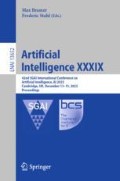Abstract
Public hospitals receive large volumes of pathology results everyday. It is therefore challenging for doctors to comprehensively analyse all this data. Pathology data prioritisation would seem to provide at least a partial solution. It has been suggested that deep learning techniques can be used to construct pathology data prioritisation models. However, due to the resource required to obtain sufficient prioritisation training and test data, the usage of deep learning, which requires large labelled training data sets, was found not to be viable. The idea presented in this paper is to use a small seed set of labelled data and then to augment this data. The motivation here was that data augmentation had been previously employed successfully to address data scarcity problems. Four data augmentation methods are considered in this paper and used to train deep learning pathology data prioritisation models. Evaluation was conducted using Urea and Electrolytes pathology data. The results show a best recall and precision of 0.73 and 0.71 respectively.
Access this chapter
Tax calculation will be finalised at checkout
Purchases are for personal use only
References
Azeez, D., Gan, K., Ali, M., Ismail, M.: Secondary triage classification using an ensemble random forest technique. Technol. Health Care 23(4), 419–428 (2015)
Bayer, M., Kaufhold, M.A., Reuter, C.: A survey on data augmentation for text classification. ACM Comput. Surv. (2021)
Chang, Z., Zhang, Y., Chen, W.: Effective adam-optimized LSTM neural network for electricity price forecasting. In: 2018 IEEE 9th International Conference on Software Engineering and Service Science (ICSESS), pp. 245–248. IEEE (2018)
Do, E., Boynton, J., Lee, B.S., Lustgarten, D.: Data augmentation for 12-lead ECG beat classification. SN Comput. Sci. 3(1), 1–17 (2022)
Iwana, B.K., Uchida, S.: An empirical survey of data augmentation for time series classification with neural networks. PLoS ONE 16(7), e0254841 (2021)
Iwana, B.K., Uchida, S.: Time series data augmentation for neural networks by time warping with a discriminative teacher. In: 2020 25th International Conference on Pattern Recognition (ICPR), pp. 3558–3565. IEEE (2021)
Jiao, X., Li, J.: An effective intrusion detection model for class-imbalanced learning based on smote and attention mechanism. In: 2021 18th International Conference on Privacy, Security and Trust (PST), pp. 1–6. IEEE (2021)
Kijpaisalratana, N., Sanglertsinlapachai, D., Techaratsami, S., Musikatavorn, K., Saoraya, J.: Machine learning algorithms for early sepsis detection in the emergency department: a retrospective study. Int. J. Med. Inform. 160, 104689 (2022)
Ni, R., Goldblum, M., Sharaf, A., Kong, K., Goldstein, T.: Data augmentation for meta-learning. In: International Conference on Machine Learning, pp. 8152–8161. PMLR (2021)
Qi, J., Burnside, G., Charnley, P., Coenen, F.: Event-based pathology data prioritisation: a study using multi-variate time series classification. In: Proceedings of the 13th International Joint Conference on Knowledge Discovery, Knowledge Engineering and Knowledge Management - KDIR, pp. 121–128. INSTICC, SciTePress (2021)
Qi, J., Burnside, G., Charnley, P., Coenen, F.: Ranking pathology data in the absence of a ground truth. In: Artificial Intelligence XXXVIII, pp. 209–223. Springer International Publishing (2021). https://doi.org/10.1007/978-3-030-91100-3_18
Raita, Y., Goto, T., Faridi, M.K., Brown, D.F., Camargo, C.A., Hasegawa, K.: Emergency department triage prediction of clinical outcomes using machine learning models. Crit. Care 23(1), 1–13 (2019)
Rasjid, Z.E., Setiawan, R., Effendi, A.: A comparison: prediction of death and infected COVID-19 cases in Indonesia using time series smoothing and LSTM neural network. Procedia Comput. Sci. 179, 982–988 (2021)
Talavera, E., Iglesias, G., González-Prieto, Á., Mozo, A., Gómez-Canaval, S.: Data augmentation techniques in time series domain: a survey and taxonomy. arXiv preprint arXiv:2206.13508 (2022)
Wang, S.T.: Construct an optimal triage prediction model: a case study of the emergency department of a teaching hospital in Taiwan. J. Med. Syst. 37(5), 1–11 (2013)
Wee, C.K., et al.: Automated triaging medical referral for otorhinolaryngology using data mining and machine learning techniques. IEEE Access 10, 44531–44548 (2022)
Wee, C.K., et al.: Triaging medical referrals based on clinical prioritisation criteria using machine learning techniques. Int. J. Environ. Res. Public Health 19(12), 7384 (2022)
Yang, X., Zhang, Z., Cui, X., Cui, R.: A time series data augmentation method based on dynamic time warping. In: 2021 International Conference on Computer Communication and Artificial Intelligence (CCAI), pp. 116–120. IEEE (2021)
Author information
Authors and Affiliations
Corresponding author
Editor information
Editors and Affiliations
Rights and permissions
Copyright information
© 2022 The Author(s), under exclusive license to Springer Nature Switzerland AG
About this paper
Cite this paper
Qi, J., Burnside, G., Coenen, F. (2022). Data Augmentation for Pathology Prioritisation: An Improved LSTM-Based Approach. In: Bramer, M., Stahl, F. (eds) Artificial Intelligence XXXIX. SGAI-AI 2022. Lecture Notes in Computer Science(), vol 13652. Springer, Cham. https://doi.org/10.1007/978-3-031-21441-7_4
Download citation
DOI: https://doi.org/10.1007/978-3-031-21441-7_4
Published:
Publisher Name: Springer, Cham
Print ISBN: 978-3-031-21440-0
Online ISBN: 978-3-031-21441-7
eBook Packages: Computer ScienceComputer Science (R0)

